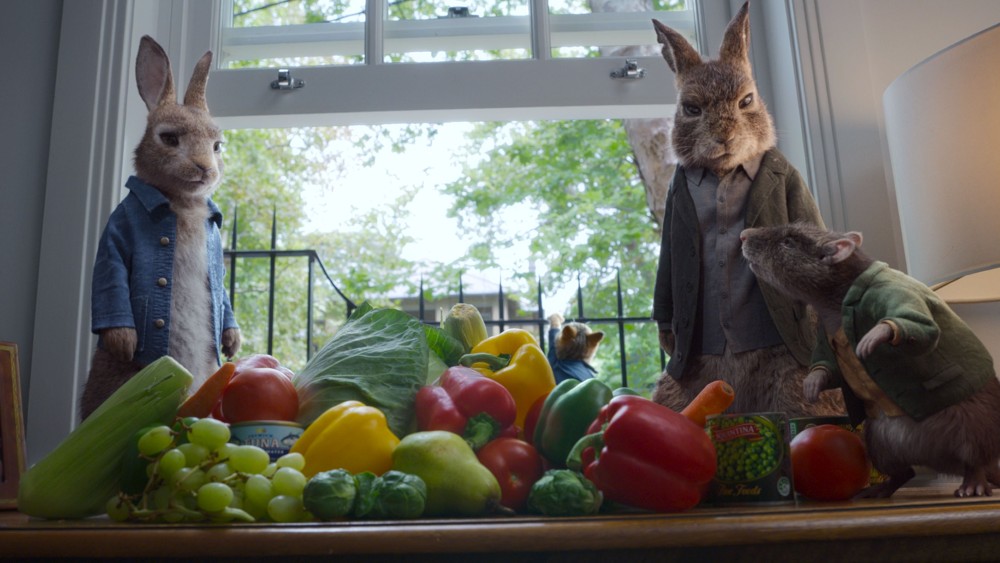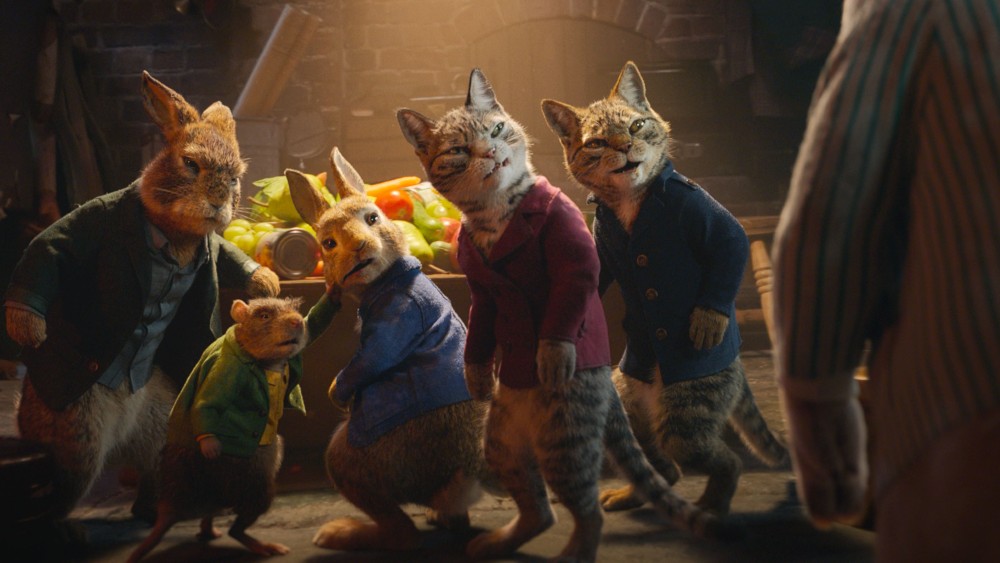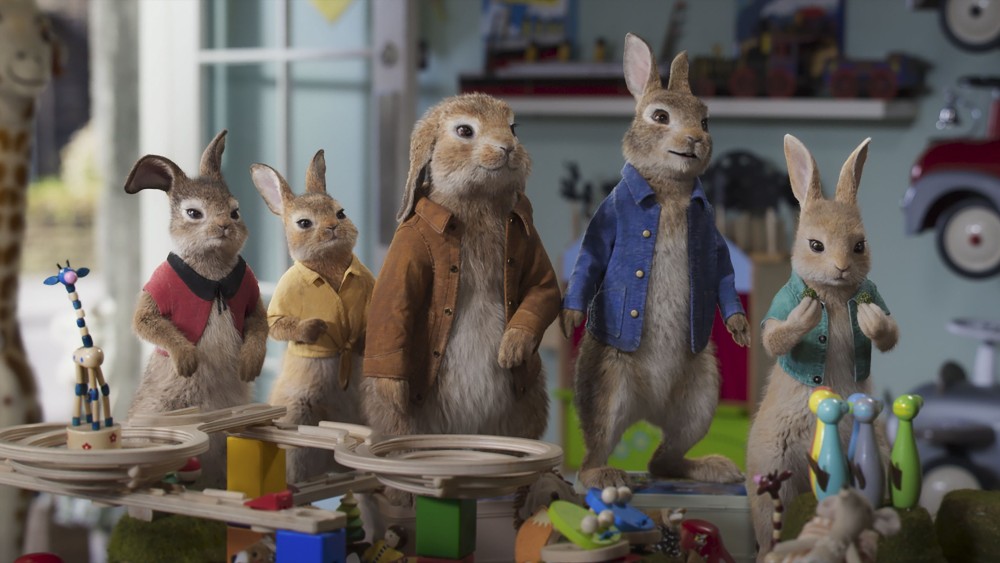
For Director Will Gluck, making Peter Rabbit 2: The Runaway may have only slightly been easier than making its 2018 predecessor, Peter Rabbit, because he and his entire cast and crew were already used to dealing with the CG animal characters that Rose Byrne and Domhnall Gleeson would be interacting with in almost every scene. Unfortunately, a little thing called COVID-19 threw off Sony Pictures’ plans to release the movie over Easter weekend in 2020, but it’s now finally in theaters despite being ready to go last year.
In the sequel, Byrne’s “Bea” has gotten the attention of a big publisher with her book about Peter Rabbit (voiced by James Corden) and his family, so she and the rabbits head to London to meet with Nigel Basil-Jones (David Oyelowo) about making the rabbits even more beloved literary characters. That is, except for Peter, who Bea’s new husband Thomas (Domhnall Gleeson) claims to be a troublemaker. Dejected, Peter runs away and joins in with an older street rabbit named Barnabus (voiced by Lennie James) to commit robberies, usually involving vegetables.
Once again, taking the characters made famous by Beatrix Potter, Gluck — who co-wrote and co-produced the movie — has made a family movie that isn’t just for the kids who love Potter’s books, but also includes running gags and other elements that can keep parents thoroughly entertained.
More importantly, he has worked with production house, Animal Logic, to make Peter and his animal friends feel so realistic that it’s hard to believe that they were added to the live action segments of the movie in post.
Below the Line got on the phone with Gluck last week for the following interview.
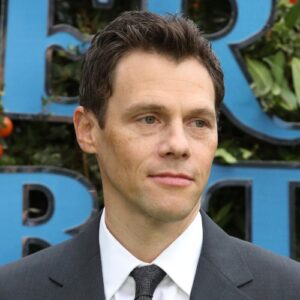
Below the Line: You obviously did a number of live action comedies and a musical with Annie, so what got you interested in shifting over to Peter Rabbit, a heavy CG hybrid film?
Will Gluck: Life changes depending on your life, so I had kids, I’ve always loved Peter Rabbit, and this is like my Marvel movie. I always wanted to play around with CG, give it a shot, and, boy, it was more difficult than I thought. [chuckles]
BTL: I was really impressed with the CG element of both films and how it integrates with the live action, which is always tough. When you directed the first movie, what were some of the challenges adjusting to having actors interacting with CG characters?
Gluck: I always say that being a director is having the illusion of control, and in one of these movies, you don’t even have the illusion. You just have to basically just give your complete trust in the VFX. department and CGI department that stuff is going to work. What I was really obsessed with in the first movie and the second movie, too, is that I wanted to feel like these characters were really there. I didn’t want it to feel like we just stuck them in. What that becomes is not only a CG challenge, but what it really becomes is a special effects challenge on set. They really wanted to feel that every time an animal moved or interacted with something, the real world moved, and felt like it was being interacted with. So that was a big challenge with all the craft people in the films to really make it feel like something was going through the environment. And then you add to the fact that the actors are acting against nothing, just became a real challenge, but everyone was really up for it. By the time you get the second movie, people have kind of figured out how to do it. So it was fun to go back and do it again with the same people, [with whom] we learned how to do it all.
BTL: Probably the part that impressed me most is when Peter is fighting with Dohmnall. When Peter hits Domhnall’s face, it really moves and gets dented, and I really wondered how you did that, if you don’t mind sharing.
Gluck: I’ll tell you. It’s one of my favorite moments on set ever. We had Dohmnall Gleeson put on a blue screen glove, and we gave him a piece of foam wrapped in blue screen, a weighted piece of foam, and he had to smack himself in the face over and over again. We initially had a stuntman do it, but the stuntman was nervous about hitting him and hurting him. So Domhnall, who is such a pro and an expert, physical comedian, said, “I have to do it myself.” So for two hours with the Phantom camera at 1500 frames a second, Domhnall Gleeson smacked himself in the face under the hot Sydney sun.
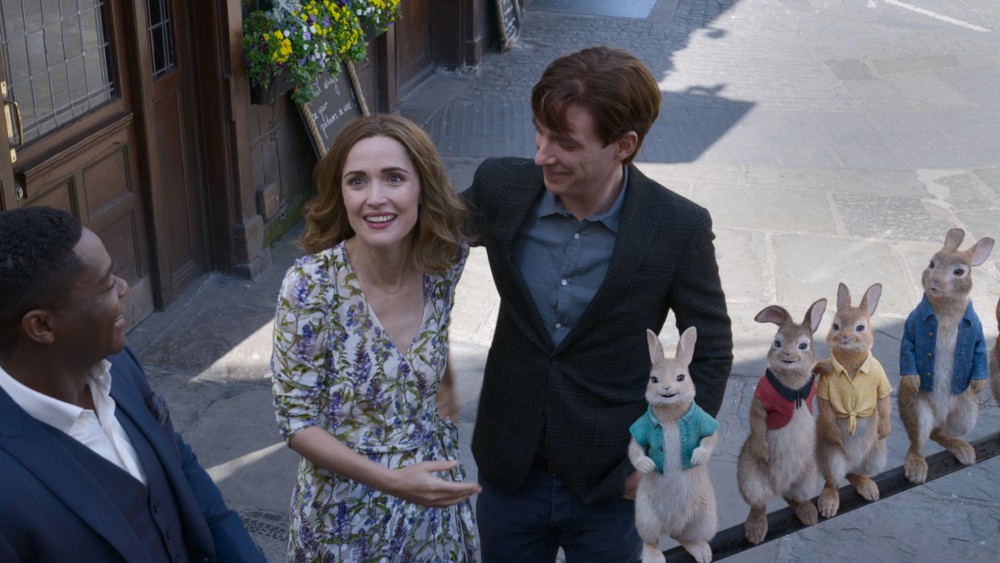
BTL: And then when the sequel comes along, and, “Okay, you gotta do it again.” Did you start writing the sequel pretty much after the first one came out? I know the first movie did well, but it also stuck around for months in theaters. Had Sony decided to do the sequel even while the first movie was still in theaters?
Gluck: Let’s see. I started writing it with my Co-writer Patrick Burleigh in May or June? The movie came out in the States in February, but it came out in the UK not until April or May, so it was still in theaters when we started doing it, and it was incredibly fast. We wrote the script, and we started prep that fall, and we started shooting that January. So it was amazing. We went from basically in theaters to a whole new movie two years later. Of course, the pandemic took a year and a half out of that, but the movie was ready to go less than two years after the first one was in theaters.
BTL: And you were able to get a lot of the same crew? I know you have a different editor but a lot of the people like Production Designer Roger Ford are the same.
Gluck: Yeah, almost everyone [except] the editor only because he moved away — it was not a personnel issue — so yeah, every single person came back, it was great.
BTL: Did you generally try to get people who were based in Australia for heads of department, and did you stay and do most of the post there as well?
Gluck: I did the post mostly from here [Los Angeles]. I think we were the most prepared for the pandemic, because we had made this whole entire movie over video conference and editing. So all the editors were in Australia, but at my house and at my office here, I had all the equipment that I could talk to the editors and be on the Avid with them in real time. Every day, I would just basically come to my office in LA and work on the movie with them in Australia in real time.
BTL: The movie was supposed to come out last April, so I assume that it was completely done, including all post, before the pandemic hit, or did you still have more work to do to finish it?
Gluck: It was coming out, and yeah, we were completely finished. We were about to get on the plane to go to the London premiere and [it] was shut down. So we had, “Hurry, hurry, hurry, to finish,” and finished in the last second, and then they locked the movie up. They don’t want you to go back in there, because once it’s done, it’s done.
BTL: I guess that’s better than if you were almost done and had to leave things unfinished. I’ve heard stories of people who were in the studio mixing and were sent home, and when they came back four months later, all the pencils and pens were still in the same place. I do want to talk more about the visual effects, because it’s such a key component. I was really amazed by what Animal Logic did in the first movie but with no nomination love from VES or other groups.
Gluck: It should have.
BTL: It’s some of the best visual effects character work I’ve seen, and that’s even more the case when you see it on the big screen.
Gluck: They should have won every award. I think it’s because people don’t think it’s like… if this movie was really Peter Rabbit and we just shot frame for frame the Peter Rabbit books, they’d have won every award because, what they did with their design and the way they put [Peter] into the movies, and the fur on these guys, it’s just unbelievable. And they got even better in the second movie. I mean, they’re just amazing. I think they’re the best in the world.
BTL: I think in the first movie, they even had the CG characters transform into 2D animation like the original Potter artwork or vice versa.
Gluck: A lot of the effects artists and in animation, a lot of the people started working at Disney like 30 years ago. So these amazing artists we have now are doing CG, but we said, “We want to do a sequence that looks like 2D animation.” They just loved that and it brought them back to their original days, and we had some of the artists doing it that worked on the original Disney stuff. It was amazing for them to do that, too, and it was fun. It’s watching 2D go to 3D in real life.
BTL: You mentioned Dohmnall hitting himself to create that effect, but there are a lot of scenes where he or Rose had to interact with different animal characters, not just Peter. Did you have anyone on set doing the voices or doing something for them to interact with?
Gluck: I would do all the voices if they ever interacted from behind the camera, just to give them something, but initially, they would do it with just like a blue stuffy, called a maquette, that was sitting there. If it moved, we would either drag the maquette with a line for the eyeline or we’d use a laser for them. We were obsessed with the eyelines in this movie to make sure it looked… A lot of the time you see movies, and you don’t feel like they’re actually there. And then we always did a pass with nothing. They just did it with absolutely nothing after the third or fourth or fifth or sixth take. So many times those are the takes that got into the film, because their muscle memory by that point was so on point that we’re able to use those takes. What they’ve done, those two and David Oyelowo, and the other actors, to be able to interact with these animals that have real emotional scenes like Domhnall has an emotional scene with Peter on the side of the road. A real emotional scene about fatherhood, and he’s acting to nothing, and I’m the voice behind him doing the voice, so it was really hard for them.
BTL: I imagine there must have been a learning curve on the first movie for everyone, that it must have been easier the second time around,
Gluck: For sure. It was a big learning curve, but also since the first one came out, we all knew that it worked. So then when we came back to the second one with the crew and the actors and us, we had so much more faith that it was going to work. Once you kind of believe it’s going to work then it was much easier, much easier. There’s no doubting anymore. Even the craziest thing, like if our VFX Supervisor Will Reichelt said, “No, you have to look over here.” Even though it doesn’t look right. Trust me like there’s complete trust, and he was right. They were right.
BTL: A lot of the crew had done movies like this before…
Gluck: Yeah, because almost the whole Animal Logic crew, they did all the Lego movies, they did Guardians of Ga’Hoole, they did Happy Feet, so they know what they’re doing.
BTL: There’s also a digital double of Domhnall that gets all mangled.
Gluck: That’s real. I don’t know what you’re talking about.
BTL: I also want to talk about the musical choices. I think the first movie even got nominated by a Music Supervisors Guild award. I was curious how involved you are in picking the songs and working with the music supervisor to get them.
Gluck: I mean, I’m extremely involved in it, and music is such a big part of all my movies. Before I even start cutting a scene or even filming a scene I kind of know what music is going to be in there. My music supervisor Wende Crowley, who had been with me for my entire career. She’s been with me for every single film and TV show I’ve ever done. She’s the absolute best, and she’s won awards for her movies, and the testament to her is that about eight years ago, she left the music supervision business and became a senior executive at ATV Sony Music. I think she’s Executive Vice President, but part of her deal was that she gets to supervise my projects. She just does my stuff and is an executive at Sony, and she’s the absolute best, and she knows my taste, she introduces me to things. The big thing about this movie is that we have a lot of on-camera visual vocals, because the squirrel sings the songs. That’s a lot of talk and we have to do that pretty early on in the process, because they’re singing the song. She’s not only the best creatively, but she also pushes me in the right direction, and then the absolute best getting permission from these songwriters to let me use their songs. I mean, the first one is when we used Pocketful of Sunshine for Easy A. The fact that Natasha Bedingfield even allowed us to use that song was ridiculous, and that’s because of Wendy lobbying her.
BTL: By the way, who voiced the squirrel and sang the songs?
Gluck: It’s a very famous Australian comedian named Tim Minchin. He wrote the music and lyrics to Matilda, so he’s a very famous, great, funny singer and comedian.
BTL: It was a nice gag with a great callback. I made the mistake of looking at the “projects in development” section of your IMDB page.
Gluck: Oh, that was a mistake.
BTL: There’s almost 100 movies. Have you mainly been writing during COVID or developing things to direct next? What’s the next thing you might do?
Gluck: During COVID, my company has like five shows on TV right now, so I’ve been busy with shepherding those, but I wrote three movies and two TV pilots during COVID, so we’re gonna make one of them in the fall. The short answer is I’ve been writing during COVID, and it’s quite painful writing when you can’t make something, so it’s been a painful time.
BTL: Have your TV shows been in production during COVID?
Gluck: Well, one of the shows for Netflix is a big animated show, so that didn’t stop at all, because we could continue to do the animated show. We have a show on Hulu called Woke. This is the second year now, and we had to push the second year a little bit because of COVID, but we just had a table read for it, and now it’s being filmed with COVID protocols. We have another show called Encore on Disney+, which we had to shut down because of COVID. So yeah, it definitely affected us.
BTL: Other than the COVID protocols, did you find you were able to get back to where you left off, or was there a lot of feeling around trying to figure it out?
Gluck: I think the COVID protocols are getting better and easier now. I think now it’s okay, and I think we’re kind of here to stay with those protocols. I think it is what it is. As long as people are working, who cares what you have to do to do it?
BTL: It’s amazing to watch movies that were obviously shot in 2019. It was great talking to you again, Will. I really enjoyed both movies, and I hope I can talk to the visual effects people sometime, because I really feel the work they’ve done shouldn’t be overlooked like the first movie.
Gluck: They won all the Australian awards, but this should not be overlooked. These guys are so amazing. They’re so talented, it’s crazy.
Peter Rabbit 2: The Runaway is now playing in movie theaters nationwide. All pictures courtesy of Sony Pictures, except where noted.

